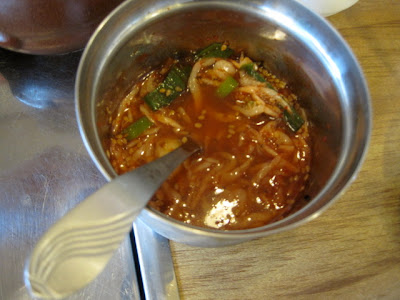Lately, with the chilly weather setting in, all I've been wanting to cook at home is variations on the theme of Indian-style curry.
I got this recipe from a cookbook by Madhur Jaffrey, which I found a copy of in my university's library (somewhat unexpectedly). Here's the recipe, with my modifications and notes:
Chickpea, Potato and Cabbage Curry (from Guyana)
From Madhur Jaffrey's "From Curries to Kebabs: Recipes from the Indian Spice Trail." Clarkson Potter 2003.
Serves 4 to 6
1 cup dried chickpeas
1 cup chopped onion
4 cloves garlic, chopped
2 wiri-wiri peppers, 1/8 of a congo pepper (scotch bonnet; habanero), without seeds, or 3 bird's eye chiles, chopped
4 Tablespoons corn, peanut, or olive oil
1 Tablespoon hot curry powder
1 teaspoon roasted and ground cumin seeds
3 medium potatoes (about 1 pound), peeled and cut into 3/4-inch dice
1.5 teaspoons salt, or to taste
4.5 cups green cabbage, its leaves cut into 1/2-inch squares (or substitute 1 large bunch spinach, chopped)
Soak the chickpeas overnight in 5 cups of water. Drain the next day, put in a pan, add 5 cups of fresh water, and bring to a boil. Cover, reduce the heat to low, and cook very gently for 1 to 3 hours, or until the chickpeas are very tender. If the water in the pan threatens to dry out, add more boiling water. Drain the chickpeas, reserving the cooking liquid. Pour the liquid into a measuring cup and add enough water to make 2.5 cups.
Put the onion, garlic, peppers, and 4 Tablespoons of water into a blender and blend until smooth.
Pour the oil into a heavy, preferably nonstick, lidded pan and set over medium-high head. Put in the paste from the blender. Stir and fry for 2-3 minutes, then reduce the heat to medium-low. Cover and cook for a further 2-3 minutes, removing the lid to stir frequently. Add the curry powder and roasted cumin. Stir once and put in the chickpeas, potatoes, salt, and the mixture of chickpea-cooking liquid and water. Bring to a boil, cover, reduce the heat, and cook gently, stirring now and then, for 20-25 minutes, or until the potatoes are tender. Add the cabbage and a further 1 cup of water. Stir and bring to a simmer. Cover and simmer gently for 10-15 minutes, or until the cabbage has just softened. Taste for salt before serving. My serving suggestions: Serve with pickle and rice, or tortillas browned over a gas flame and buttered (a good substitute for naan or chapatis, I've found) if you like.
My notes: I substituted one bunch of spinach (it's been so cheap and good these days) for the cabbage. If you use spinach, you don't need to cook the curry for as long at the end (maybe just 5 extra minutes) since spinach cooks so fast compared to cabbage.
Since I don't have a food processor, the garlic cloves were smashed with a mortar and pestle instead, and I finely minced the onion and chiles (I just substituted 2 green gochu with the seeds removed). I didn't add the 4 Tbsp water either.
For the "hot curry powder," I mixed about equal amounts (about one generous Tablespoon each) of 1) ground red pepper and 2) ground coriander.
****
Just went to the Foreign Food Mart in Itaewon to stock up on more chickpeas, and now I'm set to make this again next week! So good, cheap, and easy.






 As much as I love Korean food, sometimes I just crave something from back home, like a proper (quote unquote) American breakfast. Before moving here, I wondered what I would miss the most, and actually predicted one thing right: bacon. Real bacon: not the uncured samgyupsal that everyone is crazy about here and that I also enjoy, but salty, cured, crispy bacon. Not only do I miss bacon, but also biscuits and gravy (hard for me to make with only a teeny tiny toaster oven) and good sausages. I can do eggs at home – we have a lot of British-ish breakfasts consisting of fried eggs, toast-and-jam, and baked beans (thanks to HomePlus a.k.a. Tesco's in Korea) and sometimes do pancakes or potato hash, but it's those breakfast meats that I typically crave.
As much as I love Korean food, sometimes I just crave something from back home, like a proper (quote unquote) American breakfast. Before moving here, I wondered what I would miss the most, and actually predicted one thing right: bacon. Real bacon: not the uncured samgyupsal that everyone is crazy about here and that I also enjoy, but salty, cured, crispy bacon. Not only do I miss bacon, but also biscuits and gravy (hard for me to make with only a teeny tiny toaster oven) and good sausages. I can do eggs at home – we have a lot of British-ish breakfasts consisting of fried eggs, toast-and-jam, and baked beans (thanks to HomePlus a.k.a. Tesco's in Korea) and sometimes do pancakes or potato hash, but it's those breakfast meats that I typically crave.












